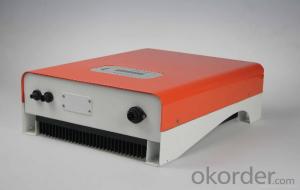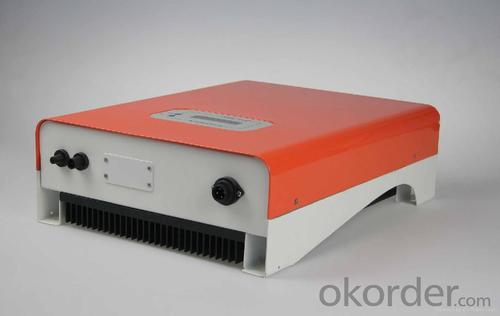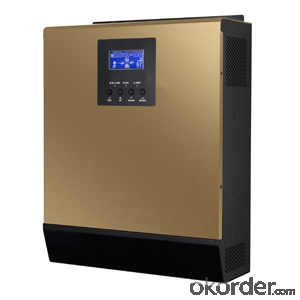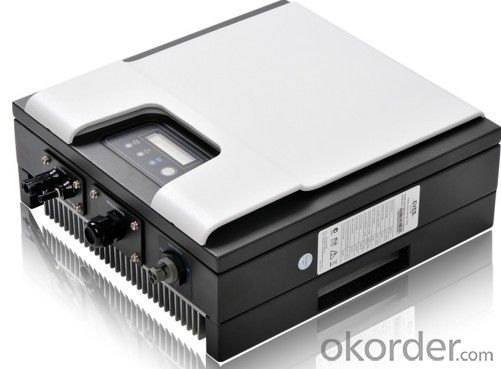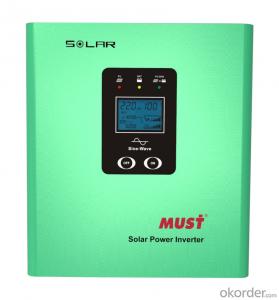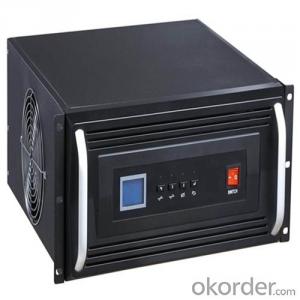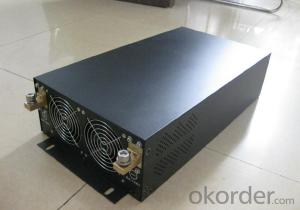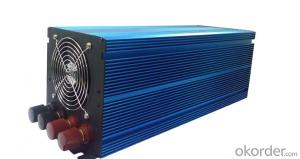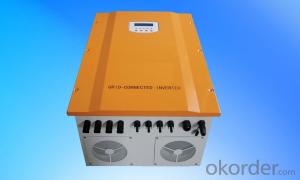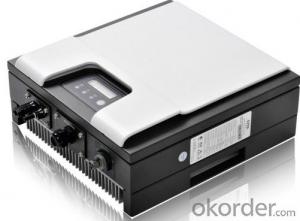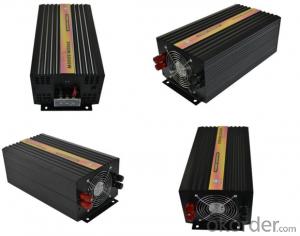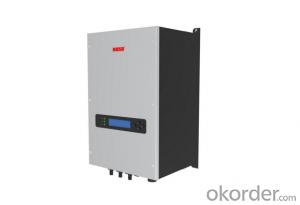All in One Solar Inverter - 3 Phase Inverter Second Generation 6k Solar Inverter Made in China
- Loading Port:
- Shanghai
- Payment Terms:
- TT OR LC
- Min Order Qty:
- 0 watt
- Supply Capability:
- 10000 watt/month
OKorder Service Pledge
OKorder Financial Service
You Might Also Like
Description of Three Phase Inverter Second Generation 6k Solar Inverter
Solar ac power system consists of solar panels, charge controllers, inverter and battery; Solar energy does not include inverter dc power system. Inverter is a kind of power conversion device, inverter by incentives can be divided into self-excited oscillation inverter and separately excited oscillation inverter.
Features of Three Phase Inverter Second Generation 6k Solar Inverter
Standard 10 years warranty, 5-15 years optional
Built-in Gprs as option
Built-in Wifi as option
Smaller and lighter, only 18kg
High performance DSP for algorithm control
VDE-AR-N 4105 certification
New topology design
Dual MPPT design
Multi-button touch interface
LCD screen visible at night
Have anti-shading function
Advantages of Three Phase Inverter Second Generation 6k Solar Inverter
Longer life cycle
Plug and play
Free monitoring through our webportal
Very lower internal temperature
Easy transportation and installation
Faster CPU speed
Adjustable active and reactive power
Maximum conversion effciency up to 98.3%,Euro up to 97.7%
More flexible system design
User friendly operation
Technical Data of Three Phase Inverter Second Generation 6k Solar Inverter
| Type | Omniksol-6k-TL2-TH |
| Input(DC) | |
| Max.PV Power | 6300W |
| Max,DC Voltage | 1000V |
| Nominal DC Voltage | 640V |
| Operating MPPT Voltage Range | 150-800V |
| MPPT Voltage Range at Nominal Power | 270-800V |
| Start up DC Voltage | 180V |
| Turn off DC Voltage | 150V |
| Max, DC Current(A/B) | 11A/11A |
| Max, Short Cicuit Current for each MPPT | 16A/16A |
| Number of MPP trackers | 2 |
| Number of DC Connection | A:2/B:2 |
| DC Connection Type | MC4 connector |
| Output(AC) | |
| Max,AC Apparent Power | 6000VA |
| Nominal AC Power (cos phi = 1) | 6000W |
| Nominal Grid Voltage | 220V/230V/240V |
| Nominal Grid Frequency | 50Hz/60Hz |
| Max, AC Current | 9.2A |
| Grid Voltage Range** | 185-276V |
| Grid Frequency Range** | 45-55Hz/55-65Hz |
| Power Factor | 0.9 capacitive... 0.9 inductive |
| Total Harmonic Distortion(THD) | <2% |
| Feed in Starting Power | 30W |
| Night time Power Consumption | <1W |
| Standby Consumption | <10W |
| AC Connection Type | Plug-in connertor |
| Efficiency | |
| Max,Efficiency | 98.2% |
| Euro Efficiency | 97.5% |
| MPPT Efficiency | 99.9% |
| Safety and Protection | |
| DC Insulation Monitoring | Yes |
| DC Switch | Optional |
| Residual Current Monitoring Unit (RCMU) | Integrated |
| Grid Monitoring with Anti-islanding | Yes |
| Electricity Fuse Protection | Yes |
| Protection Class | Ⅰ(According to IEC 62103) |
| Overvoltage Category | PVⅡ/Mains Ⅲ(According to IEC 62109-1) |
| Reference Standard | |
| Safety Standard | EN 62109, AS/NZS 3100 |
| EMC Standard | EN 6100-6-1, EN 6100-6-2, EN 6100-6-3 EN 6100-6-4, EN 6100-3-2, EN 6100-3-3 |
| Grid Standard | VDE-AR-N4105. VDE-0126-1-1,G83/1,EN 50438,RD1699,CEI 0-21, AS4777,C10/C11 |
| Physical Structure | |
| Dimensions | 352x421x154.5mm |
| Weight | 18kg |
| Environmental Protection Rating | IP 65 (According to IEC 60529) |
| Cooling Concept | Natural convection |
| Mounting Information | Wall bracket |
| General Data | |
| Operating Temperature Range | -25℃ to +60℃(derating above 45℃) |
| Relative Humidity | 0% to 98%, no condensation |
| Max. Altitude (above sea level) | 2000m |
| Noise Type | <40dB |
| Isolation Type | Transformerless |
| Display | 20 x 4 LCD (800x480 TFT Graphic Display optional) |
| Data Communication | RS485(WiFi, GRPS optional) |
| Computer Communication | USB |
| Standard Warranty | 10 Years (5-15 years optional) |
IMages of Three Phase Inverter Second Generation 6k Solar Inverter
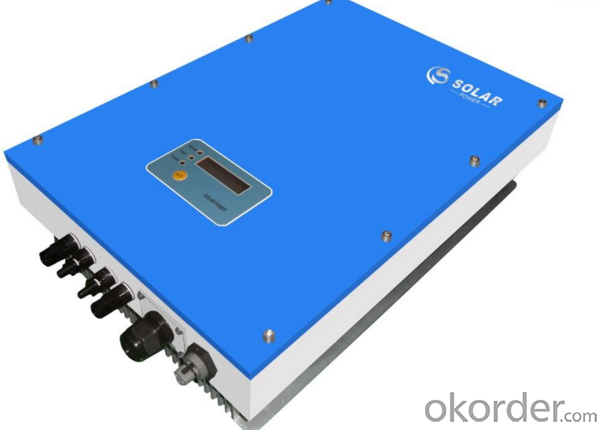
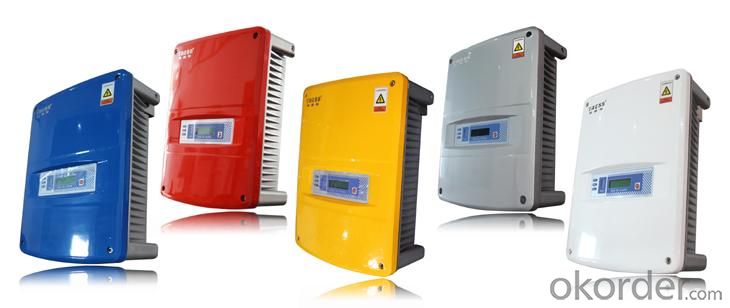
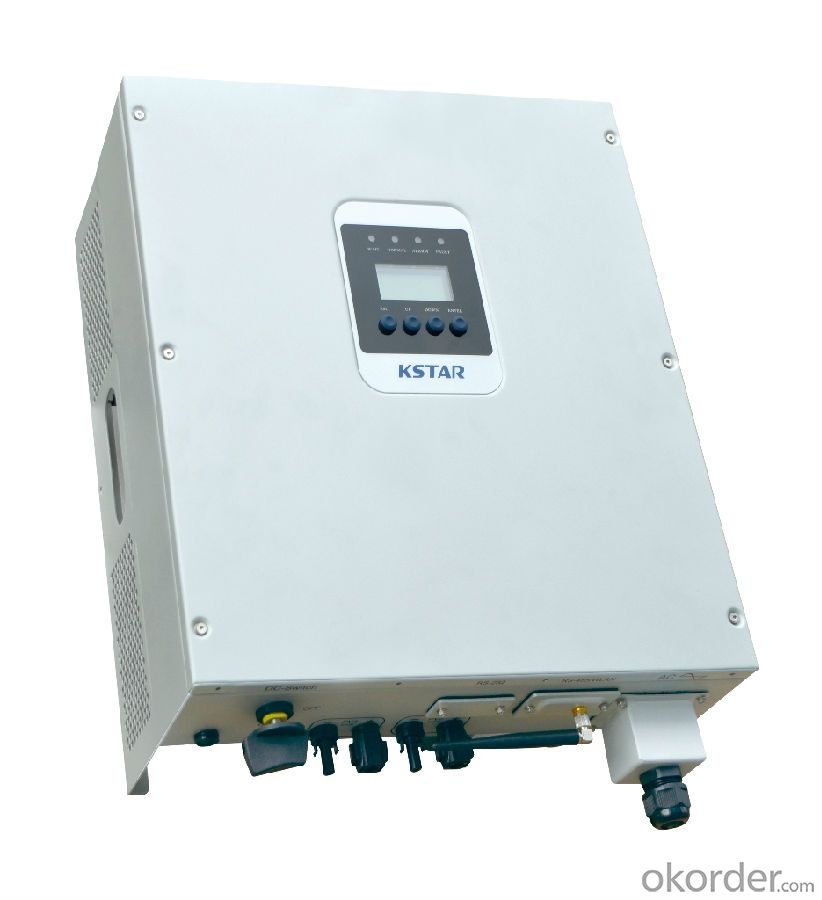
FAQ
Q: Do you have the CE, TUV, UL Certification?
A: We’ve already passed all the tests, and any certificate is available.
Q: Have you ever sold your products to companies in my country?
A: Of course, we have customers in all general PV markets, but I think we should expand our market share along with the market growth.
Q: When did your company set up? You are a new company, how can I believe your quality?
A: We entered into Solar PV industry in 2005, now we have several plants in manufacturing of a-Si and c-Si panels, and our capacity is 220MW per year. Till now we have already passed all the tests by authorized laboratories, e.g. TUV, CE, UL.
Q: Can you help us install the module if we cooperate with you?
A: We haven’t entered into installation sector, but we have the plan in near future.
Q: How do you pack your products?
A: We have rich experience on how to pack the panels to make sure the safety on shipment when it arrives at the destination.
Q: Can you do OEM for us?
A: Yes, we can.
Q: Can we visit your factory?
A: Surely, I will arrange the trip basing on your business schedule.
- Q: Are there any electromagnetic interference concerns associated with solar inverters?
- Yes, there can be electromagnetic interference concerns associated with solar inverters. These concerns mainly arise from the high-frequency switching of power electronics within the inverters. However, modern solar inverters are designed to minimize electromagnetic interference through the use of appropriate filters and shielding techniques. Compliance with relevant electromagnetic compatibility (EMC) standards ensures that solar inverters do not interfere with other electronic devices and are safe to use in residential and commercial settings.
- Q: Can a solar inverter be used with a solar-powered backup generator?
- Yes, a solar inverter can be used with a solar-powered backup generator. A solar inverter is responsible for converting the DC (direct current) electricity generated by solar panels into AC (alternating current) electricity that can be used to power household appliances and other electrical devices. A solar-powered backup generator, on the other hand, uses solar energy to charge its batteries or store excess electricity. When the solar panels are generating electricity, the solar inverter will convert the DC electricity into AC electricity, which can be used directly in the household or sent back to the grid if the system is connected to it. If there is excess electricity being generated and the batteries of the solar-powered backup generator are fully charged, the solar inverter can divert the excess electricity to other loads or devices. During periods when solar energy is insufficient or not available, the solar-powered backup generator can kick in and provide the necessary electricity to power the house or recharge the batteries. In this case, the solar inverter will still be responsible for converting the DC electricity generated by the solar-powered backup generator into AC electricity. So, to summarize, a solar inverter can definitely be used with a solar-powered backup generator to ensure a continuous supply of electricity even when solar energy is limited.
- Q: Are there any government incentives for installing solar inverters?
- Yes, there are government incentives available for installing solar inverters. Many countries offer tax credits, grants, or rebates to encourage the adoption of solar energy. These incentives vary depending on the region and may also include net metering programs or feed-in tariffs, which allow solar system owners to sell excess electricity back to the grid. It is advisable to research and consult local government agencies or renewable energy organizations to determine the specific incentives available in your area.
- Q: How does a solar inverter synchronize with the grid?
- A solar inverter synchronizes with the grid by constantly monitoring the grid's frequency and voltage. It adjusts its own output frequency and voltage to match the grid's, ensuring that the solar energy it produces is in sync with the electricity supplied by the grid. This synchronization process allows the solar inverter to safely and efficiently inject solar power into the grid, while also allowing for seamless transition between solar and grid power.
- Q: Can a solar inverter be used with different solar panel brands?
- Yes, a solar inverter can be used with different solar panel brands as long as they have compatible voltage and current ratings. However, it is recommended to consult the manufacturer's specifications and guidelines to ensure optimal performance and compatibility.
- Q: Can a solar inverter be used in regions with high temperature extremes?
- Yes, solar inverters can be used in regions with high temperature extremes. However, it is important to consider the temperature range specified by the manufacturer for optimal performance and efficiency. Extreme heat may affect the inverter's efficiency and longevity, so proper cooling and ventilation should be ensured in such conditions.
- Q: Can a solar inverter be used in systems with multiple inverters?
- Yes, a solar inverter can be used in systems with multiple inverters. In fact, in large-scale solar installations, multiple inverters are often used to handle the increased power output. These inverters are connected in parallel or series to ensure efficient and reliable operation of the entire system.
- Q: How does a three-phase solar inverter differ from a single-phase inverter?
- A three-phase solar inverter differs from a single-phase inverter in terms of the number of phases they support. While a single-phase inverter is designed to work with a single-phase electrical system, a three-phase solar inverter is specifically designed to handle three-phase electrical systems. This means that a three-phase inverter can handle higher power loads and is more efficient in distributing power across the three phases, resulting in better overall performance and stability for three-phase electrical systems.
- Q: What is the difference between a string inverter and a microinverter?
- A string inverter is a central inverter that converts the DC power generated by multiple solar panels connected in series into AC power. On the other hand, a microinverter is a smaller inverter that is attached to each individual solar panel, converting the DC power generated by each panel into AC power. The main difference is that string inverters are used for multiple panels, while microinverters are used for individual panels.
- Q: What is the role of isolation in a solar inverter?
- The role of isolation in a solar inverter is to provide safety and protect the user from electrical shocks. It separates the input and output sides of the inverter, ensuring that any faults or disturbances on one side do not affect the other. Isolation also helps to minimize electrical noise and interference, improving the overall performance and reliability of the solar inverter.
Send your message to us
All in One Solar Inverter - 3 Phase Inverter Second Generation 6k Solar Inverter Made in China
- Loading Port:
- Shanghai
- Payment Terms:
- TT OR LC
- Min Order Qty:
- 0 watt
- Supply Capability:
- 10000 watt/month
OKorder Service Pledge
OKorder Financial Service
Similar products
Hot products
Hot Searches
Related keywords
